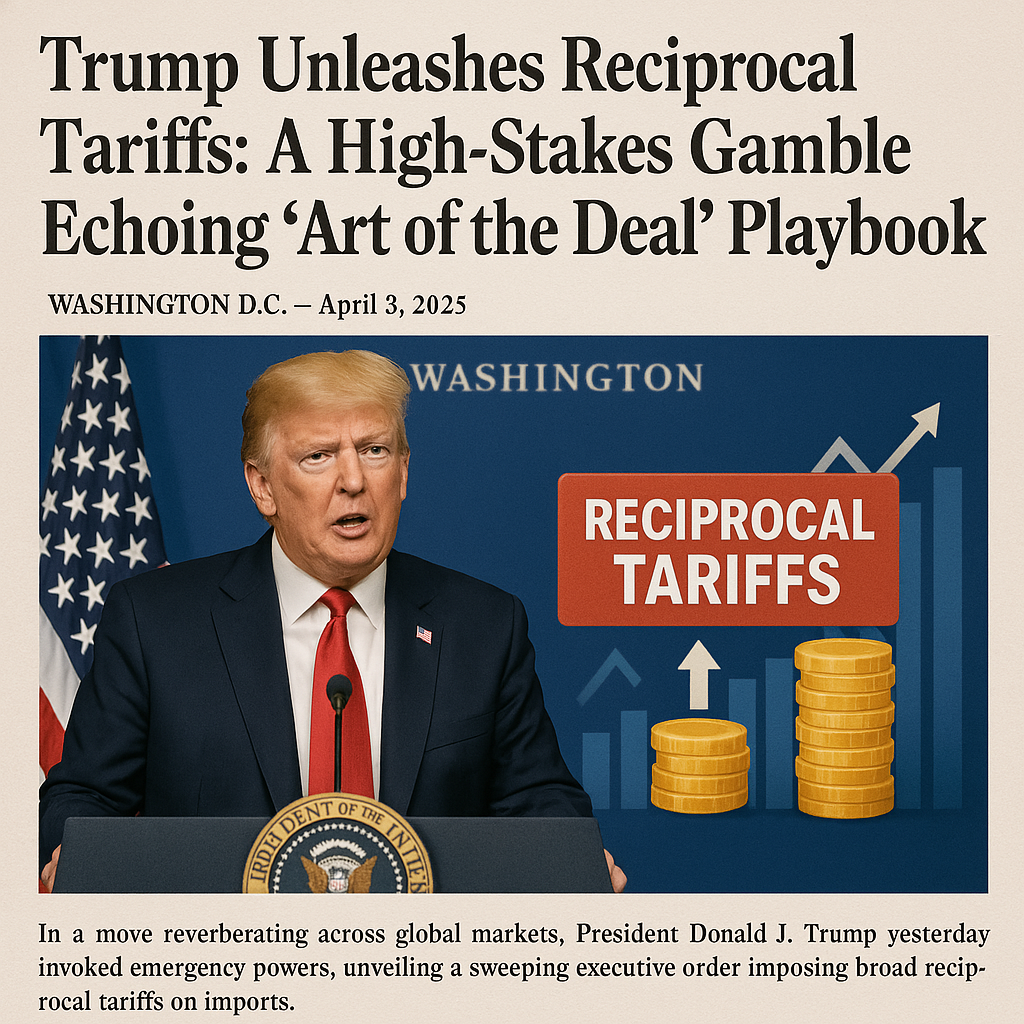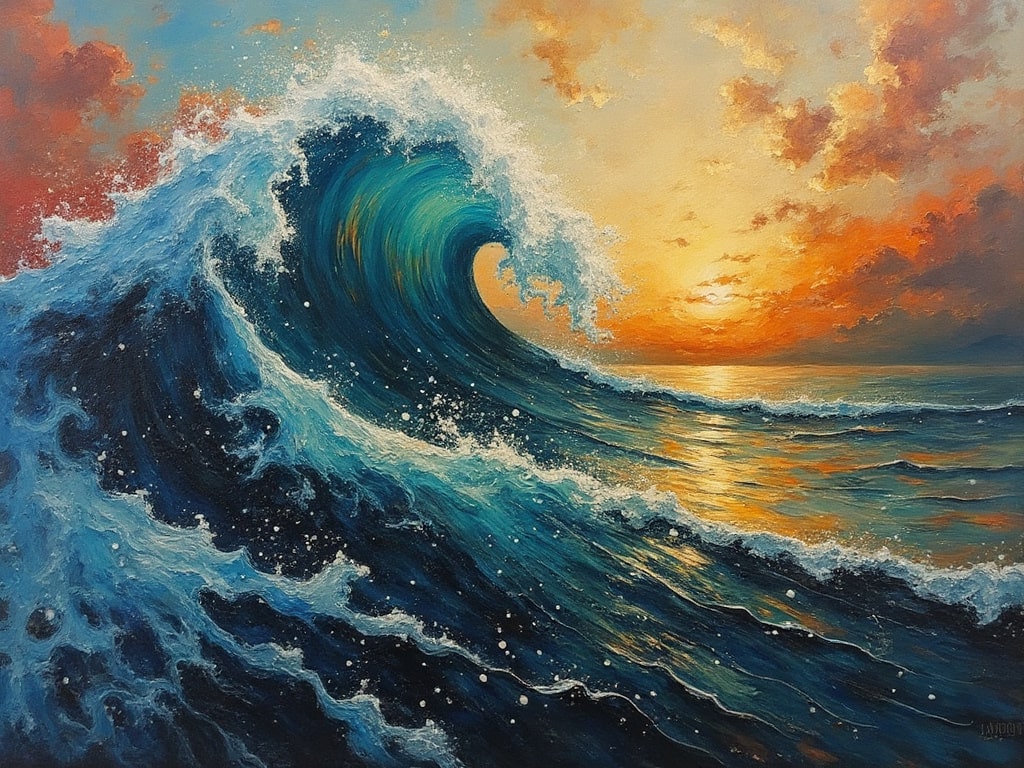
In a move reverberating across global markets, President Donald J. Trump yesterday invoked emergency powers, unveiling a sweeping executive order imposing broad reciprocal tariffs on imports. Citing large and persistent U.S. goods trade deficits—now reportedly exceeding $1.2 trillion annually—as an “unusual and extraordinary threat to the national security and economy,” the President declared a national emergency, setting the stage for a dramatic reshaping of America’s trade relationships. This bold, confrontational strategy, detailed in the extensive executive order “Regulating Imports with a Reciprocal Tariff,” is being widely interpreted as a direct application of the aggressive deal-making principles famously outlined in Trump’s 1987 bestseller, “The Art of the Deal.”
The executive order establishes an initial 10% additional ad valorem duty on nearly all imports, set to take effect shortly, with provisions for significantly higher, country-specific tariffs against major trading partners listed in an annex, including economic powerhouses like China and the European Union. This decisive action, rooted in the administration’s “America First Trade Policy,” directly addresses what the order describes as a fundamental lack of reciprocity in global trade, marked by disparate tariff rates, pervasive non-tariff barriers, and foreign economic policies that allegedly suppress wages and consumption abroad, unfairly disadvantaging U.S. producers and contributing to the “hollowing out” of American manufacturing.
Observers familiar with President Trump’s long-professed business philosophy immediately recognized the hallmarks of “The Art of the Deal” in this expansive policy shift. The book, though focused on real estate, championed principles like thinking big, using leverage relentlessly, fighting back against perceived unfairness, protecting the downside, and employing bravado—all elements seemingly on display in the new tariff regime.
Thinking Big and Aiming High: The sheer scale of the executive order—a near-universal tariff designed to fundamentally rebalance global trade flows—epitomizes the “think big” mantra central to Trump’s deal-making ethos. Rather than incremental adjustments, the order represents a monumental attempt to overhaul decades of U.S. trade policy, aiming for a dramatic impact rather than marginal gains.
Leverage as the Ultimate Tool: “The Art of the Deal” emphasizes dealing from strength and creating leverage. The newly imposed tariffs function precisely as that: a powerful lever designed to compel trading partners to lower their own barriers to U.S. goods and address non-reciprocal practices. By making access to the vast U.S. market more costly, the administration aims to force concessions. The order explicitly reserves the right to increase tariffs further should partners retaliate (Sec. 4(b)) or decrease them if partners take “significant steps to remedy” imbalances (Sec. 4(c)), showcasing a dynamic use of leverage akin to high-stakes negotiation.
Fighting Back and Confrontation: Trump’s book advises fighting back hard when treated unfairly. The executive order frames the trade deficit and associated manufacturing decline as the result of decades of unfair treatment and failed assumptions within the global trading system. The tariffs represent a direct, confrontational response, rejecting the existing framework and aggressively pushing back against trading partners and international norms deemed detrimental to American interests. The justification points fingers at specific higher tariff rates imposed by others (e.g., EU car tariffs, Indian tech tariffs) and a litany of non-tariff barriers detailed in the National Trade Estimate Report.
Protecting the Downside: While often perceived as a gambler, “The Art of the Deal” preaches conservatism by focusing on protecting the downside. The executive order’s rationale heavily emphasizes protecting America’s “downside”—its national security, economic security, manufacturing base, defense-industrial capacity, and even agricultural sector (noting the shift from surplus to a projected $49 billion deficit). The tariffs are presented as a necessary defensive measure against the threats posed by reliance on foreign supply chains, geopolitical disruptions, and the erosion of domestic production capabilities, including critical military stockpiles.
Knowing Your Market (and Sticking to Your Guns): Trump’s book advocates for developing a strong “gut feeling” about the market and trusting one’s instincts. The executive order reflects a deeply held conviction about the causes of trade imbalances and the necessity of tariffs, dismissing decades of conventional trade wisdom. It presents a specific diagnosis—failed reciprocity, suppressed foreign consumption (citing lower consumption-to-GDP ratios in China, Germany, etc.)—and prescribes a specific cure, demonstrating persistence in a vision pursued since his first term. The mention of R&D spending shifting overseas further underscores this specific market interpretation.
Bravado and Getting the Word Out: Issuing such a far-reaching executive order under the banner of a national emergency is inherently a bold, headline-grabbing act, consistent with the “truthful hyperbole” and self-promotion tactics discussed in “The Art of the Deal.” It sends an unmistakable message of resolve to both domestic audiences and international partners, ensuring maximum attention for the administration’s policy goals.
The order does include exemptions for certain critical goods (pharmaceuticals, semiconductors, energy, critical minerals, detailed in Annex II), previously tariffed steel and aluminum, and initially preserves preferential treatment for USMCA-originating goods from Canada and Mexico (though non-originating goods face duties tied to separate border EOs). It also notes adjustments based on U.S. content, attempts to address transshipment via Hong Kong and Macau, and anticipates changes to de minimis rules.
However, the core thrust remains a dramatic, unilateral assertion of American economic power, justified by national emergency. Whether this massive gamble, seemingly drawn straight from the “Art of the Deal” playbook, will successfully revitalize American manufacturing, rebalance trade, and strengthen national security—or ignite damaging trade wars and harm consumers—remains the critical question. What is certain is that the President is applying his signature deal-making style to the complex arena of international trade on an unprecedented scale, betting that confrontation and leverage can reshape the global economic landscape in America’s favor. The coming months will reveal the consequences of this high-stakes application of the “art of the deal” to global commerce.
